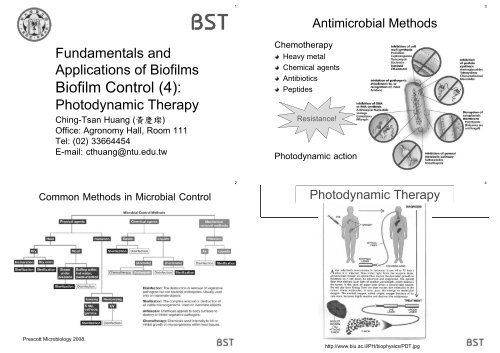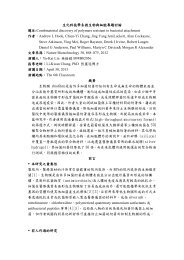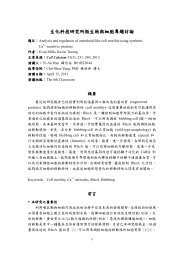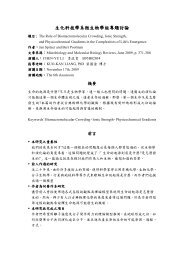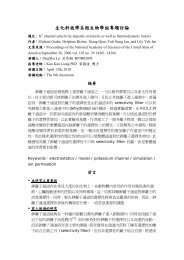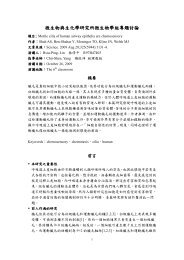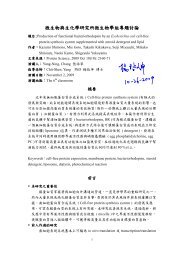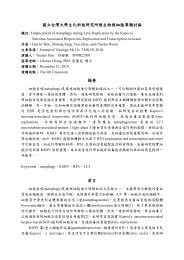Common Methods in Microbial Control
Common Methods in Microbial Control
Common Methods in Microbial Control
Create successful ePaper yourself
Turn your PDF publications into a flip-book with our unique Google optimized e-Paper software.
Ch<strong>in</strong>g-Tsan Huang (黃慶璨)<br />
Office: Agronomy Hall, Room 111<br />
Tel: (02) 33664454<br />
E-mail: cthuang@ntu.edu.tw<br />
<strong>Common</strong> <strong>Methods</strong> <strong>in</strong> <strong>Microbial</strong> <strong>Control</strong><br />
Prescott Microbiology 2008.<br />
1<br />
2<br />
Chemotherapy<br />
Heavy metal<br />
Chemical agents<br />
Antibiotics<br />
Peptides<br />
Resistance!<br />
Photodynamic action<br />
http://www.biu.ac.il/PH/biophysics/PDT.jpg<br />
3<br />
4
Nature reviews cancer, 2003 (3) 380-7<br />
Characteristics<br />
PS<br />
Selective adsorption or b<strong>in</strong>d<strong>in</strong>g by cancer cells<br />
Different rates of metabolism between normal and<br />
cancer cells<br />
Excitation by an appropriate wavelength<br />
Porphyr<strong>in</strong>s<br />
Cyan<strong>in</strong>e dyes<br />
qu<strong>in</strong>ones<br />
5<br />
6<br />
J Dent Res. 86(11):<br />
1126, 2007.<br />
Ref : Malik et al. 1990<br />
7<br />
8
-Am<strong>in</strong>olaevul<strong>in</strong>ic acid<br />
(ALA): Endogenous<br />
ALA<br />
PpIX<br />
Small range of wavelength<br />
White light<br />
Halogen lamp<br />
LED (Light Emitt<strong>in</strong>g Diode)<br />
Merocyan<strong>in</strong>e 540<br />
(MC 540): Exogenous<br />
Laser (Light Amplification by Stimulated<br />
Emission of Radiation )<br />
9<br />
10<br />
Interact with cells only<br />
No adsorption or neutralization by EPS<br />
MW is generally small<br />
Less transport limitation<br />
B<strong>in</strong>d<strong>in</strong>g to cells<br />
Not related to physiology<br />
Already exist <strong>in</strong> cells<br />
Less chance to <strong>in</strong>duce resistant stra<strong>in</strong>s<br />
11<br />
12
http://www.erc.montana.edu/MultiCellStrat/06-Meet<strong>in</strong>g_Antimic-Challenge/SuscpHypotheses.htm<br />
J Dent Res. 86(11):<br />
1126, 2007.<br />
13<br />
14<br />
Periodontol 2000.<br />
2009;51:109-40.<br />
PACT with TBO-Gold Nanorods<br />
Chem. Commun., 2009, 4853 - 4855<br />
15<br />
16
8<br />
<br />
S. aureus<br />
Relation between<br />
antimicrobial activity<br />
and excitation level of<br />
MC 540<br />
: 1-fold<br />
: 2-fold<br />
: 5-fold<br />
: 10-fold<br />
Incubation time (m<strong>in</strong>)<br />
: 5 µg/ml<br />
:10 µg/ml<br />
: 15 µg/ml<br />
: 20 µg/ml<br />
17<br />
18<br />
S. aureus<br />
MC540-mediated PDT on<br />
antimicrobial activity and<br />
excitation level of MC540<br />
: 0 µg/ml<br />
: 5 µg/ml<br />
: 10 µg/ml<br />
: 15 µg/ml<br />
: 20 µg/ml<br />
Light dose (J/cm 2 )<br />
A threshold value of photosensitizer<br />
excited is required to reach complete<br />
kill.<br />
19<br />
20
S. aureus<br />
Irradiation on<br />
antimicrobial activity<br />
and excitation level<br />
of MC 540<br />
: 0 µg/ml<br />
: 5 µg/ml<br />
: 10 µg/ml<br />
: 15 µg/ml<br />
: 20 µg/ml<br />
21<br />
22<br />
0 J/cm 2 30 J/cm 2 60 J/cm 2<br />
20 m<br />
150 J/cm 2 300 J/cm 2 600 J/cm 2<br />
Pump LED<br />
Material<br />
23<br />
24
Step 1<br />
Step 2<br />
Initiative conc.: 10 8 cells/mL<br />
Interaction conc.: 10 7 cells/mL<br />
Step 3<br />
Step 4<br />
MSSA MRSA<br />
25<br />
26<br />
P. aerug<strong>in</strong>osa<br />
Relation between antimicrobial activity and<br />
excitation level of -ALA<br />
With irradiation Without irradiation<br />
360 J cm -2<br />
120 J cm -2<br />
240 J cm -2<br />
P. aerug<strong>in</strong>osa<br />
Irradiation on excitation level of -ALA<br />
120 J cm -2<br />
<strong>Control</strong><br />
27<br />
28
Regrowth (recovery)<br />
A rapid resumption of biofilms after antimicrobial<br />
treatment was term<strong>in</strong>ated.<br />
The rema<strong>in</strong><strong>in</strong>g biofilms conta<strong>in</strong> enough viable<br />
organisms.<br />
The residual biofilm enhances transport and sorption<br />
of microbial cells and other compounds to the surface.<br />
Some oxidiz<strong>in</strong>g antimicrobial agents preferentially<br />
removes EPS and not biofilm cells.<br />
EPS is rapidly created by surviv<strong>in</strong>g organisms.<br />
P. aerug<strong>in</strong>osa<br />
Regrowth after -ALA-mediated PDT<br />
1st 2nd<br />
<strong>Control</strong><br />
29<br />
30<br />
Microorganisms<br />
Photosensitizers<br />
Exogenous PS<br />
MC540, MB, HpD<br />
Endogenous PS<br />
-ALA<br />
Natural PS<br />
C-Phycocyan<strong>in</strong><br />
Bacteria<br />
Gram + Gram -<br />
S. aureus P. aerug<strong>in</strong>osa<br />
S. epidermidis E. coli<br />
S. aureus<br />
S. epidermidis<br />
S. aureus<br />
S. epidermidis<br />
P. aerug<strong>in</strong>osa<br />
E. coli<br />
P. aerug<strong>in</strong>osa<br />
E. coli<br />
Gram-positive cell wall Gram-negative cell wall<br />
31<br />
32


